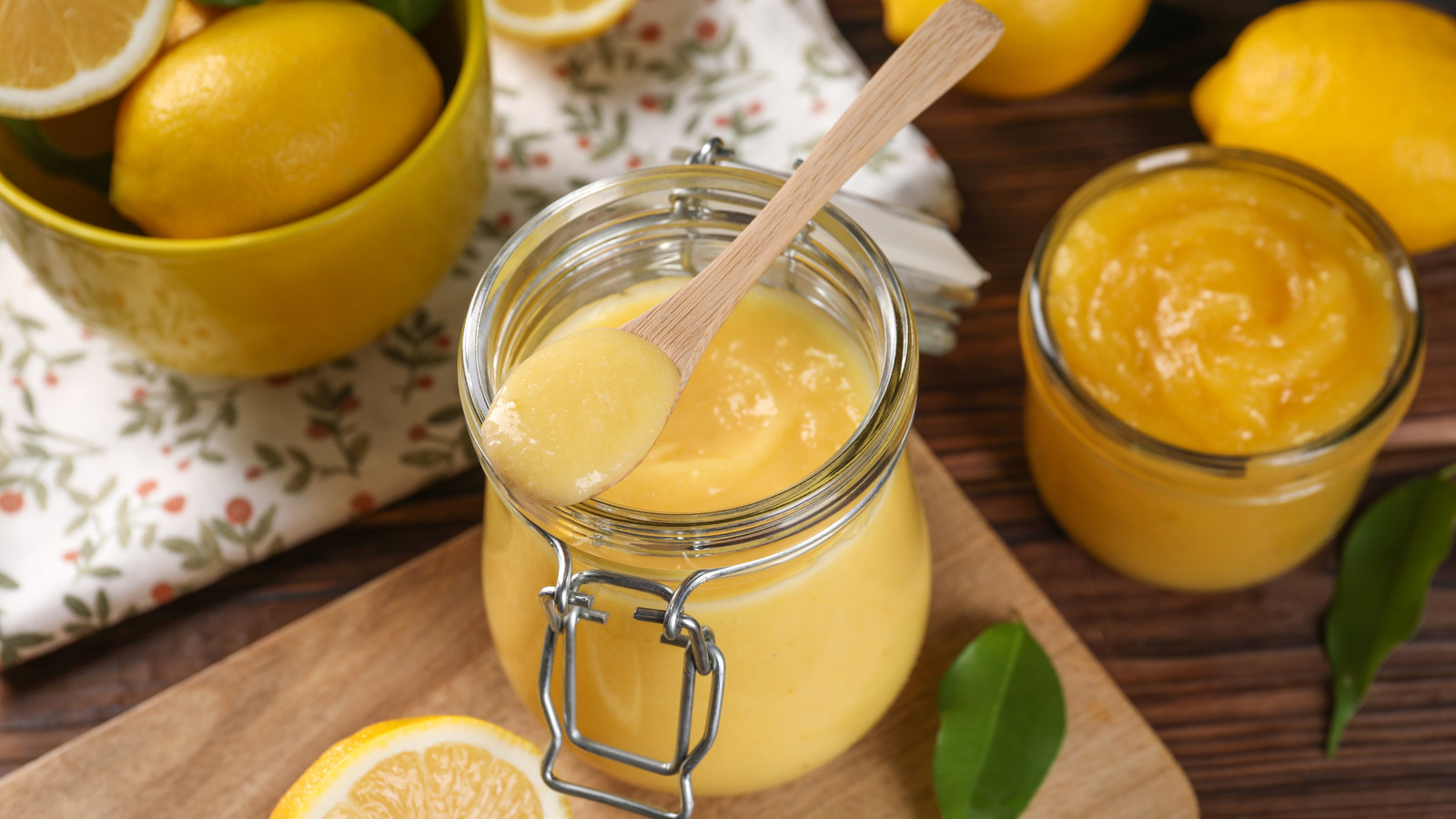There are some ingredients that every home baker should have in their arsenal, including the mainstays: flour, leavening agents, sugar, and butter. But we’re going to propose another, slightly more unconventional addition that everyone should have on hand: lemon curd. Lemon curd is a custard-like topping made by cooking down butter, lemon juice, sugar, butter (which can be substituted with olive oil), and eggs on the stovetop or in the microwave until a creamy mixture forms. This easy-to-make ingredient has the perfect mashup of tart and sweet flavors, and its thick texture makes it easy to spread on an array of foods.
If you’re working with a recipe that calls for a scant amount of homemade or store-bought lemon curd, you may be scratching your head about how to use up the rest of it before it goes bad. But fear not, as we have compiled a list of some of our favorite ways to put this versatile, and an arguably pantry staple ingredient to good use.
1. Add it to your crêpe filling
Crêpes are the definition of a Sunday brunch food. They’re more intensive to make than a batch of eggs or a defrosted frozen breakfast sandwich, and they can easily be dressed up with an array of adornments, both sweet and savory. If you’re after a sweet brunch, consider adding lemon curd to your crêpes.
Lemon curd is sharp, tangy, and creamy, which is the perfect contrast to the eggy and relatively neutral-tasting crêpe shell. The curd can act as a standalone filling, but it certainly plays well with others as well. Freshly sliced strawberries, or a handful of blueberries or raspberries, can add a contrasting texture and elevate your breakfast. Or, consider amping up the creaminess by adding in a scoop of mascarpone or ricotta before closing your crêpes and plating. Be sure to finish your plate with a sprinkle of powdered sugar and a dollop of whipped cream for both presentation and to contrast the sharp curd inside.
2. Use it as a filling for layer cakes
Layer cakes are a tasty treat, but they require some patience to make them yourself. Not only do you have to master a perfectly soft sponge and silky smooth icing, but you also have to nail down the perfect filling. While a decadent chocolate ganache is suitable for some occasions, and pie filling can offer a toothsome, fruity bite, lemon curd should also be worthy of consideration.
It would be the perfect filling for a springtime or early summer cake, especially paired with a white or yellow sponge. While you could go the lemon-on-lemon route and whip up a lemon-infused sponge, we find that lemon is sometimes best used in small doses — and your curd has more than enough of it to go around. Besides imparting a beautifully light and refreshing flavor to your layer cake, lemon curd is also a great filling because it’s not super wet, so you won’t have to worry about it soaking through your sponge and turning your cake soggy.
You don’t have to stick to just a lemon filling, either. Try accenting your curd with freshly sliced strawberries, or swirl together the curd with raspberries or strawberry preserves for a fun marbled effect.
3. Swipe it on pancakes
Peanut butter and jelly, burgers and fries, pancakes and maple syrup — they’re things that just go together. But, there’s no shame in wanting to break out of the mold and try something different on your favorite short stack — like lemon curd. Pancakes and waffles both tend to be super heavy on the palate and can make you feel heavier after you eat a single one — and sometimes adding more syrup isn’t the best remedy. Lemon curd will offer a subtle and refreshing profile and it works well with other fresh fruit toppings, including fresh strawberries, raspberries, or blueberries.
While lemon curd will work just fine with standard, store-bought pancake mix, we really love combining it with a homemade ricotta pancake recipe. The whipped egg whites will help keep each bite light and fluffy, while the ricotta adds some much-needed moisture and fat to the recipe. The addition of lemon zest and juice in the batter will also create synergy with your curd topping, making for a wholesome bite.
4. Spread it on scones
Scones and jam certainly isn’t an unfamiliar pairing, so why not try your next batch of homemade scones with lemon curd? This topping can be used solo, or added to your scones along with another classic topping, clotted cream, or plain butter. If you’re working with a scone batter that doesn’t really have a lot going on in the flavor department, using a flavorful topping like curd can really help to elevate the bite. It can also work well with a fruit-infused scone, like one made with freeze-dried strawberries or cranberries, or one that’s topped with a just-flavorful-enough lemon glaze.
Besides just offering a great and refreshing flavor, the curd also offers the perfect textural contrast against the crumbly and dry scone. It’s a worthwhile pairing if you’re a scone lover, or if you want to be able to control how much lemon flavor you add to your breakfast.
5. Top your cheesecake with it
Once you’ve mastered the art of baking a decent cheesecake, you can start experimenting with different flavors. Heavy and sugary flavor profiles, like chocolate, Oreo, and salted caramel are viable options — but their heaviness can do the dessert a disservice. That’s why we would recommend adding a light and mildly-flavored lemon curd to your cake instead. The tart brightness of the curd pairs well with the classic cream cheese base, though it can also be used for sour cream or ricotta-infused cheesecakes as well. It enhances the overall creaminess of the dessert, rather than eclipsing it.
There are several ways to use lemon curd to flavor your cheesecake. For one, you may consider adding a little bit of curd to the cheesecake filling itself to help lighten it up. You can also stick to spooning curd atop your cheesecake when it’s almost done baking. It’s important not to bake your cake with the curd on it for the entire duration, as the sugars in it can caramelize and burn. Top your finished cheesecake (or cheesecake bars, if you’re after a more portable option) with candied lemon peels or whole lemon slices to drive home that tart-sweet dichotomy even more.
6. Add it to a sandwich
You can draw a lot of parallels between lemon curd and fruit preserves. They both have a gelatinous texture, and the respective fruit is the first-and-foremost flavor of both of them. When you think of it that way, it might not be too weird to consider adding a swipe of curd to your sandwich in the same way you would add jams, jellies, or preserves to it.
Lemon curd and peanut butter is an unforgettable sandwich combination — even though the thought of it initially might make you a little queasy. The lemon cuts through the richness of the peanut butter, while its sugariness helps balance out the salty undertones of the spread. If you are still loyal to the iconic peanut butter and jelly, though, fear not; there are tons of other sandwich combos made possible with lemon curd. For one, try a swipe of whipped cream cheese and lemon curd on a plain bagel; the tangy curd slices through the creamy and rich spread and makes for a breakfast and lunch-friendly bite.
7. Use it as a filling for pastries
One of the formative uses for lemon curd is for pastries — you know, the kind you see in a patisserie shop window and think, “Man, there is no way I can do that myself!” Lucky for you, you don’t need a degree in pastry arts to experiment with store-bought puff pastry and lemon curd at home. You can whip up a classic lemon tart with just three ingredients: the frozen dough sheets, lemon curd, and an egg wash. You can easily press the dough into a tart tin to get the perfect shape, or consider doing a more freeform design with the help of a sharp knife or cookie cutters. Like the other uses for lemon curd listed here, you don’t want to bake the curd for too long. Instead, shape your thawed puff pastry, brush on the egg wash, and bake. The curd can be added on after the pastry has cooled fully; this will prevent it from sloshing off or soaking right down into the layers of pastry underneath it.
“Pastries” extends far beyond just laminated dough. For example, you can try adding a drizzle of lemon curd to your cinnamon roll filling instead of the classic cinnamon-sugar duo. Top your rolls with a sweet cream cheese frosting and grated lemon zest.
8. Swirl lemon curd into your yogurt
Yogurt is a reliable breakfast that we are quite partial to. Spoon a little bit into a bowl, add a handful of berries and some crunchy granola, and you have a simple, tasty breakfast to enjoy on the go or at home.
If your yogurt bowl is looking a little uninspired, consider reaching for a jar of lemon curd. While both the yogurt and the curd are technically acidic, the latter has enough sweetness to enhance the natural flavor of the yogurt and lighten up each and every bite. If you’re concerned about sugar, as some yogurts (particularly flavored yogurts) pack a ton of extra sugar in, you may want to consider opting for an unflavored and unsweetened version. If you can’t stomach the taste of plain yogurt, you may find that the subtle sweetness of the lemon curd will help make it more approachable.
You can enjoy a curd-infused yogurt for breakfast or as a simple, sweet dessert to finish out your day. It would go well with a sweet and plain-ish granola, like oats and honey, or a sprinkle of chia seeds for crunch.
9. Fill your homemade donuts with it
Don’t get us wrong, making homemade donuts is nothing short of a labor of love. But, there’s a magical moment that happens when you get just the right dough texture, the perfect fry, and a knock-out filling that makes the process totally worth it.
Donuts are admittedly a heavy breakfast in terms of both their greasiness and their size. If you fill them with something like a lemon curd, you can reap the benefits of not only the refreshing lemon flavor, but also the distraction from the greasiness. It’s a win-win.
There are a few important things to note about filling donuts, whether you’re working with a lemon curd or some other filling. You’ll want to fry the donuts and let them cool before filling them with the curd. Otherwise, your curd can turn soupy and ruin the entire texture of your fried treat. Toss your donuts in powdered or granulated and serve them with a cup of strong coffee to round out your meal.
10. Use it as a filling in macarons
You might say we’re joking when we say that homemade macarons can sense fear. But, it’s a fact. If you bake them on a day that’s too humid, they may crack. If you don’t adequately dry them in the oven, they may crack. If you go so far as to look at them the wrong way, guess what? They may crack. All that’s to say that macarons are not a beginner bake.
Once you (painstakingly) master the ins and outs of making a good macaron shell, it’s time to think about your fillings. Lemon curd is a great one to start with because it’s so easy to use, and it allows you to focus on the more technical aspects of making homemade macarons — aka how to prevent the unsightly and dreaded crack. The curd is also the perfect bright contrast to the almond undertones of the macaron shell, as well as any other ingredients you may also be adding to it. While vanilla shells are a great place to start, you can also use lemon curd for one made with freeze-dried raspberries (the berry will color the shell and impart a subtle flavor without making the batter watery) or strawberries. You may even be able to explore more unconventional flavors, like basil or lavender, paired with the citrusy contrast of the lemon curd.
11. Serve it on your charcuterie board
Charcuterie is one of the most versatile and party-friendly foods out there. While you can make a whole meal out of it for one or two people, you can also make an extensive grazing board, complete with bread, cured meats, fruit, and more, to feed a crowd. One of the big mistakes that people get wrong with charcuterie is not including at least one sweet element (or in this case, spread).
Your charcuterie board should hit all the flavor parameters: sweet, savory, umami, salty, bitter, and sour. Lemon curd hits two of those notes: sweet and sour. While it might not get the same attention as fig jam or strawberry preserves, it’s still a worthy pairing for a range of crackers, baguette, and crostini. It’s also an unconventional spread pairing for Brie, which has a delectable richness that would be highlighted by the tangy curd. Round out your board with sliced fruit to complement the curd.
12. Mix it with whipped cream for a shortcut mousse
Mousse is definitely a dessert that seems more complicated to make than it actually is. It turns out that all you need to make a simple lemon mousse is whipped cream, powdered sugar, and lemon curd — how easy is that? Whisk together these three ingredients for a few minutes, making sure that all of the powdered sugar has integrated into the other ingredients and is no longer gritty. It helps to chill the bowl down in your fridge before mixing, as it maximizes the mousse’s fluffiness. Once the mixture is ready, pop it into the refrigerator for a few hours — preferably overnight — so that it sets completely. Cookbook author Justin Burke, who shared some of his top tips for better baking with us, says that he likes to use this simple mousse as a filling for cake — but also notes that it’s worthwhile to indulge in a spoonful straight from the bowl.
You can also build out this mousse into an entire dessert by layering it with cake pieces and lemon curd to create a trifle of sorts. Or, if you’re after something simple, a dollop of whipped cream, sprinkle of lemon zest, and a handful of berries would offer the perfect contrast of textures and flavors, yet still leaves the lemon center-stage.
13. Fill cookies with lemon curd
Lemon curd can be used for a filling for many tasty treats, including sandwiches and macarons. And, it turns out that cookies are also on the list, too. One classic example is a thumbprint cookie, which consists of a shortbread-sugar-cookie-esque base and a small indentation where the curd is spooned in. The result is a buttery cookie that’s not objectively sweet, but still brimming with radiant citrus undertones. Thumbprint cookies can be filled with a range of spreads, but lemon curd should be at the top of your list if you’re after a cookie that really brings the springtime energy. Top your thumbprints with a lemon drizzle, simple vanilla glaze, or leave them naked.
Another type of cookie that could benefit from a lemon curd infusion is a sandwich cookie. Two thin vanilla wafer cookies sandwiching a lemon curd filling sounds simple, but it’s nonetheless delicious. If you want to make the lemon curd shine, you can use cookie cutouts to make a play on raspberry stars — this will allow the colorful and creamy curd to poke out from underneath.
14. Swirl some into your oatmeal
Oatmeal isn’t often seen as the most flavorful of breakfasts. Sure, it’s a little plain Jane when cooked with milk or water, but there are so many ways to breathe new life into this high-fiber breakfast — including swirling it with lemon curd.
You can layer a spoonful of curd into overnight or hot oats, and add any extra enhancements, like chia seeds or Greek yogurt, to alter its texture. The curd itself is pretty agreeable to a range of flavors and textures. For one, you can layer it with fresh blueberries, strawberries, or raspberries, or try layering your overnight oats in a jar with the curd, another type of fruit preserve, and the oats. It’s just sweet and light enough to liven up the mouthfeel, but not distract from the other components at play.
15. Drizzle it on ice cream
There are many simple pleasures in life, including sitting on the couch and eating a bowl full of ice cream — or straight form the pint, if that’s more your style. If you’re looking to dress up your standard bowl of ice cream, consider reaching for a jar of lemon curd. Lemon curd has a light yet inviting flavor that can elevate a whole host of ice cream and gelato flavors. Not only does it work with the dessert’s flavor profiles, but it also offers a slightly different texture and mouthfeel that will make each bite more interesting than the last.
There are, of course, some flavors that shouldn’t be in the same room as lemon curd — mainly heavy brownie, chocolate, or fudgy flavors. But, there are more flavors that can complement the curd than you may think. Vanilla, for one, is a simple and reliable selection, but you could also use pair the curd with blueberry, mint (so long as that mint flavor is subtle, rather than so strong that it clashes with the lemon), lavender, basil, strawberry, and raspberry. You could also add a handful of fresh berries to your ice cream to complement the tangy undercurrents of the curd.





